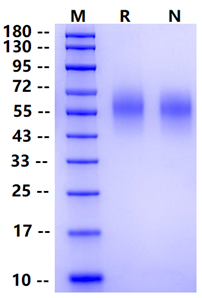Lys35-Gly320, with C-terminal His&Avi tag KLTIESTPFNVAEGKEVLLLAHNLPQNRIGYSWYKGERVDGNSLIVGYVIGTQQATPGPAYSGRETIYPNASLLIQNVTQNDTGFYTLQVIKSDLVNEEATGQFHVYPELPKPSISSNNSNPVEDKDAVAFTCEPEVQNTTYLWWVNGQSLPVSPRLQLSNGNMTLTLLSVKRNDAGSYECEIQNPASANRSDPVTLNVLYGPDVPTISPSKANYRPGENLNLSCHAASNPPAQYSWFINGTFQQSTQELFIPNITVNNSGSYMCQAHNSATGLNRTTVTMITVSGGGGSGGGSHHHHHHHHHHGLNDIFEAQKIEWHE
50-72kDa
Reconstitute at 0.1-1 mg/ml according to the size in ultrapure water after rapid centrifugation.
1. Laura A Strickland,Preclinical evaluation of carcinoembryonic cell adhesion molecule (CEACAM) 6 as potential therapy target for pancreatic adenocarcinoma,Journal of Pathology,J Pathol 2009; 218: 380-39.
CEACAM6 is a glycosylphosphoinosi-tol (GPI)-linked, cell surface protein and a member of the CEA family of proteins. Structurally, this protein has two C2-type Ig domains and a single N-terminal V-type Ig domain and shares close homology with CEACAM1, CEACAM7 and CEACAM8. Function-ally, CEACAM6 has been implicated in cell adhesion, cellular invasiveness, resistance to anoikis and metastatic behaviour of tumour cells, which are properties investigators have previously tried to exploit using various CEACAM6-targeted therapy approaches.

1μg (R: reducing conditions, N: non-reducing conditions).